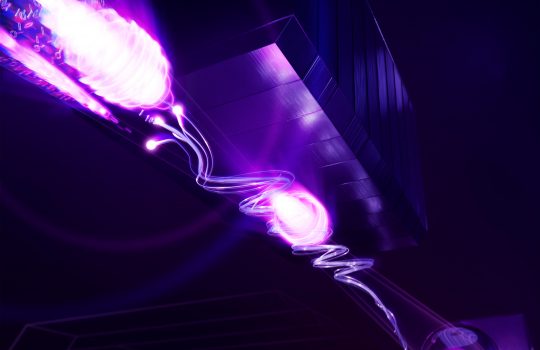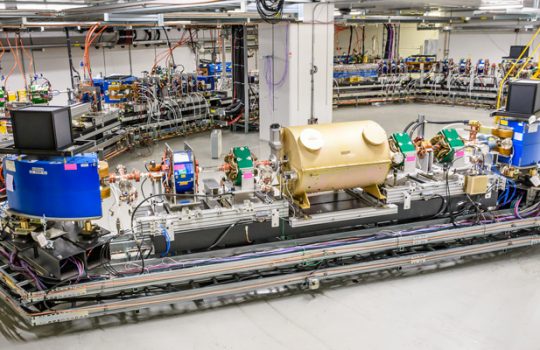Fermilab’s newest particle accelerator is small but mighty. The Integrable Optics Test Accelerator, designed to be versatile and flexible, is enabling researchers to push the frontiers of accelerator science.
Instead of smashing beams together to study subatomic particles like most high-energy physics research accelerators, IOTA is dedicated to exploring and improving the particle beams themselves.
IOTA researchers say they are excited by the observation of single-electron beams near the speed of light and the first results on decreasing beam instabilities. They are eager to use their single-electron technique to probe aspects of quantum science and see future breakthroughs in accelerator science.
“The scientists who designed the accelerator are also the scientists that use it,” said Vladimir Shiltsev, a Fermilab distinguished scientist and one of the founders of IOTA. “It’s an opportunity to get great insight into the physics of beams at relatively small cost.”
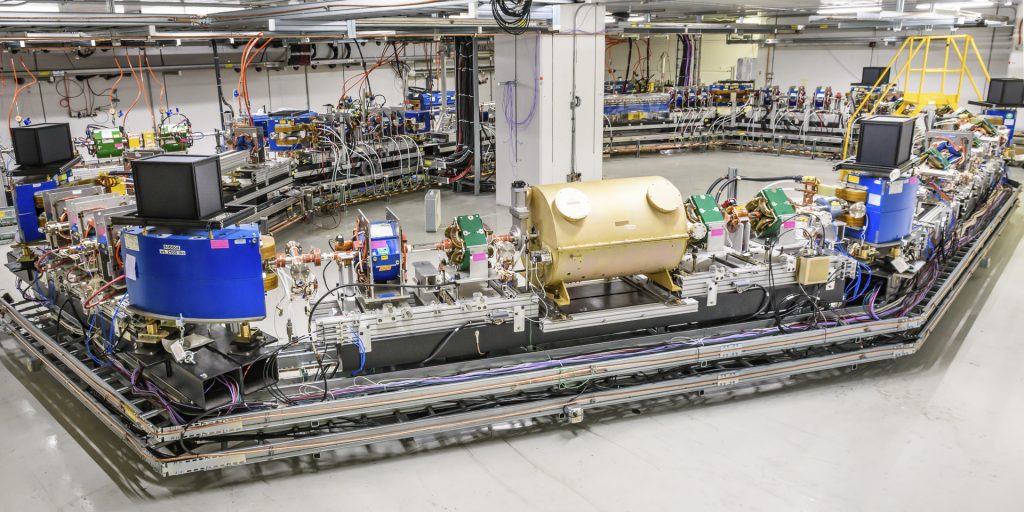
Scientists using the 40-meter-circumference Integrable Optics Test Accelerator saw their first results from IOTA this summer. Photo: Giulio Stancari
Versatility is the mother of innovation
In the Fermilab Accelerator Science and Technology facility, a particle accelerator delivers intense bursts of electrons that are then stored in IOTA’s 40-meter-circumference ring, where they circulate about 7.5 million times every second at near the speed of light. The system’s design enables a small team to adjust or exchange components in the beamline to perform a variety of experiments on the frontier of accelerator science.
“This machine was designed with a lot of flexibility in mind,” said Fermilab scientist Alexander Valishev, head of the team that developed and constructed IOTA.
Consider the accelerator magnets, which are responsible for the size and shape of the particle beam’s profile. At IOTA, every magnet is powered separately so that researchers can reconfigure the machine for completely different experiments in a few minutes. At other accelerator facilities, a comparable change could require a lengthy shutdown of weeks or months.
For research accelerators that serve researchers, the focus is typically on maximizing running time and maintaining well-understood, established beam parameters. In contrast, the IOTA team expects the accelerator to be routinely shut down, reconfigured and restarted. Its technical and operational flexibilities make it easier for outside teams to use IOTA to conduct their own experiments, exploring a variety of topics at the frontier of accelerator and beam physics.
IOTA’s versatility has already attracted groups from Lawrence Berkeley National Laboratory; Northern Illinois University; SLAC National Accelerator Laboratory; University of California, Berkeley; University of Chicago and other institutions. Not only are they conducting exciting science, but early-career researchers are also receiving valuable practical training in accelerator and beam science that can be challenging to come by.
“If you wanted to have a comparable scientific program at a more traditional facility, it would be very difficult, if not prohibitive. Typically, those facilities are designed for a narrow range of research, aren’t easily modified and require nearly continuous operation,” said Fermilab scientist Jonathan Jarvis, who works on IOTA. “But here at IOTA, we are a purpose-built facility for frontier topics in accelerator research and development, and we have those flexibilities by design.”
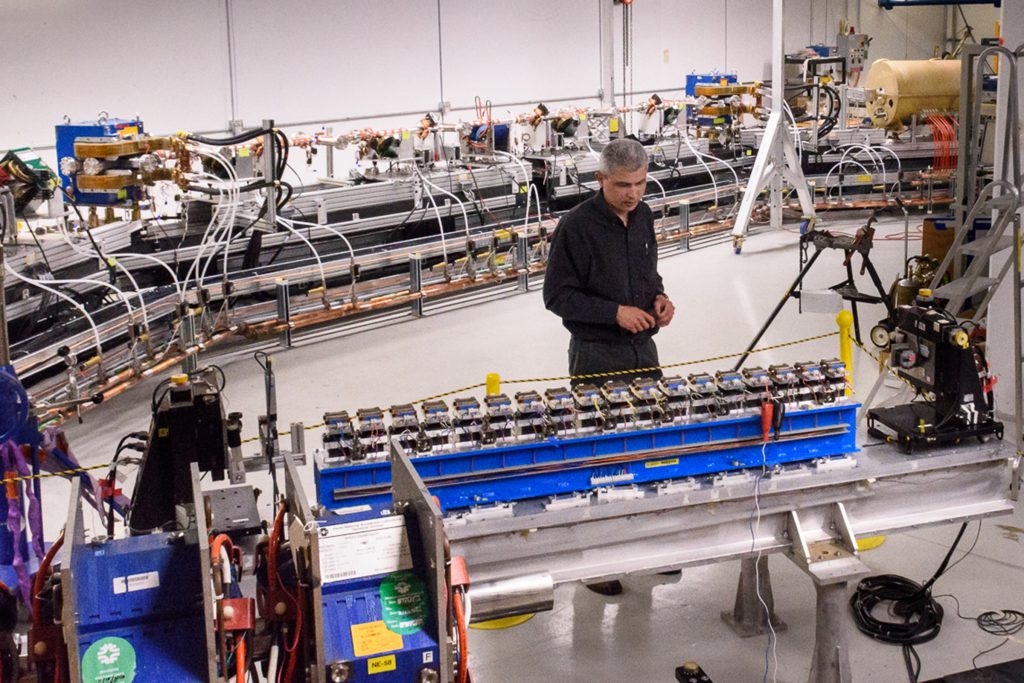
Fermilab scientist Alexander Valishev inspects the specially designed nonlinear insert that produces the nonlinear magnetic fields for IOTA experiments. Photo: Giulio Stancari
First results: Testing IOTA’s IO
As part of the only dedicated ring-based accelerator R&D facility for high-intensity beam physics in the United States, IOTA is designed to develop technologies to increase the number of particles in a beam without increasing the beam’s size and thus the size and cost of the accelerator. Since all particles in the beam have an identical charge, they electrically repel each other, and as more particles are packed into the beam, it can become unstable. Particles may behave chaotically and escape. It takes expertise and innovative technology to tame a dense particle beam.
To that end, IOTA researchers are investigating a novel technique called nonlinear integrable optics. The technique uses specially designed sets of magnets configured to prevent beam instabilities, significantly better than the configurations of magnets used over the past 50 years.
To test the nonlinear integrable optics technique, IOTA researchers deliberately produced instability in the beam. They then measured how difficult it was to provoke unstable behavior in IOTA’s electron beam both with and without the influence of the magnetic fields
The technique was a winner: Scientists observed that these specialized magnets significantly decreased the instability.
During the next run of the system, the team plans to more rigorously study this effect.
“The first result is merely a demonstration,” Valishev said. “But I think it’s already a big accomplishment.”

IOTA’s nonlinear magnets help prevent instabilities in high-intensity particle beams. Photo: Giulio Stancari
Watching a single electron near the speed of light
In a first for Fermilab, the researchers have also observed the circulation of a single electron.
The IOTA beam, when injected into the storage ring, can contain about a billion electrons. As the beam circulates, electrons tend to escape the beam due to collisions with one another or with stray gas molecules in the beam pipe. So if you want to see an electron fly solo around the ring, it is just a matter of waiting.
The real trick is being able to observe the last electron left “standing.”
The fast-moving electrons emit visible light as they travel along the curves of the ring. This light is synchrotron radiation, which is emitted when charged particles moving near the speed of light change direction. The light provides researchers with information about the beam, including how many electrons are in it.
IOTA researchers used the synchrotron radiation to observe the loss of electrons, one by one, until they finally witnessed a solitary electron.
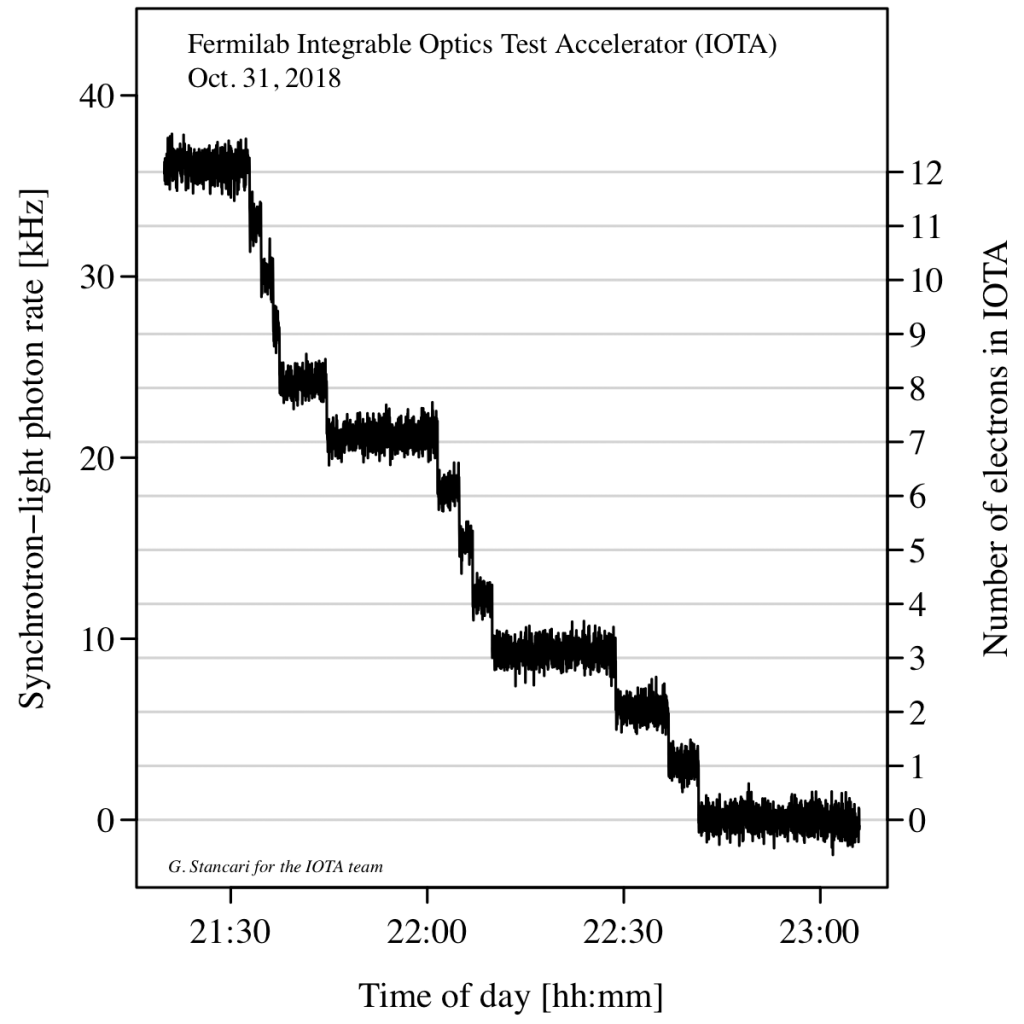
This plot illustrates the decrease in the amount of measured synchrotron light every time an electron was knocked out of the particle beam.
On their next round, rather than play the waiting game to get down to a beam of one electron, the team tried a faster, more deliberate approach. They devised a way to instead inject single electrons into IOTA on demand. It worked. The method reliably saw lone particles traveling around the ring.
The wait was over.
This feat is more than just a novel curiosity. The ability to store and observe a single electron, or even a very small number of electrons moving around at high speeds, creates opportunities to probe interesting quantum science.
“Everything we do is rather macroscopic, so you wouldn’t think of any of this facility, let alone a 40-meter ring, as a quantum instrument,” Jarvis said. “But we’ve got this situation where there’s an individual particle circulating in the ring at nearly the speed of light, and it gives us fascinating opportunities to do something that is very quantum in nature.”
For instance, in its upcoming run, IOTA will become the first facility in the world with the ability to precisely redirect synchrotron light back on the particle that generated it.
This capability opens the door to a wide variety of fundamental quantum experiments and will also enable Fermilab scientists to attempt the world’s first demonstration of a powerful technique called optical stochastic beam cooling. Generally, beam cooling methods sap accelerated particles of their chaotic or frenetic motion. Optical stochastic cooling is expected to be thousands of times stronger than the current state of the art and is a perfect example of the high-impact returns that IOTA is targeting.
“We’ve got this situation where there’s an individual particle circulating in the ring at nearly the speed of light, and it gives us fascinating opportunities to do something that is very quantum in nature.”
Accelerating into the future: proton beams, electron lenses and more
IOTA is currently set up to circulate electrons, and this work sets the stage for future, more challenging experiments with protons.
The high-energy electron beam naturally shrinks to a smaller size due to synchrotron radiation, which makes it a well-behaved system for IOTA researchers to confirm important parts of beam physics theories.
In contrast to IOTA’s electron beam, its forthcoming experiments with protons will see beam circulate at low velocity, be significantly larger and be strongly affected by the repulsive forces between beam particles. Research into the behavior of such proton beams will be integral to understanding how nonlinear integrable optics can be effectively applied in the high-power accelerators of the future.
And with both electrons and protons in the mix, scientists can also advance to another exciting phase in IOTA’s research program: electron lenses. Electron lenses are yet another technique that researchers are investigating in their quest to create stable particle beams. This technique uses the negative charge of electrons to oppose the positive charges of protons to pull the protons into a compact, stable beam. The electron lens will also allow IOTA scientists to demonstrate the nonlinear integrable optics concept using special charge distributions rather than the specialized nonlinear magnets.
With its breadth of unique capabilities, IOTA and its team are ready for several years of exciting research.
“Frontier science requires frontier research and development, and at IOTA, we are focused on realizing those major innovations that could invigorate accelerator-based high-energy physics for the next several decades,” Jarvis said.
This work is supported by the Department of Energy Office of Science.


